Neoadjuvant Therapy With Gemcitabine in Breast Cancer
Primary systemic therapy (ie, preoperative or neoadjuvant) increasesthe possibility for breast-conserving surgery in patients with primarybreast cancer. Patients with pathologic complete response to primarysystemic therapy have improved survival compared with those with persistenttumors. Several phase II trials have evaluated gemcitabine-containingdoublet or triplet regimens as primary systemic therapy for breastcancer, results of which have shown promising clinical and pathologicresponse rates with manageable toxicity. Results of a phase I/II studyof gemcitabine (Gemzar)/epirubicin (Ellence)/docetaxel (Taxotere), orGEDoc, with prophylactic filgrastim (Neupogen), as primary systemictherapy in 77 evaluable patients with primary breast cancer are reportedherein. Dose-limiting toxicities were grade 3 febrile neutropenia(n = 1) and grade 3 diarrhea (n = 2) at the fourth dose level ofGEDoc tested (gemcitabine at 800 mg/m2 days 1 and 8, epirubicin at90 mg/ m2 day 1, and docetaxel at 75 mg/m2 day 1). As assessed byultrasound, 92% of patients responded overall (22% complete response),and 79% of patients could undergo breast-conserving surgery. Thepathologic complete response rate in resected breast tissue was 26%.
Primary systemic therapy (ie, preoperative or neoadjuvant) increases the possibility for breast-conserving surgery in patients with primary breast cancer. Patients with pathologic complete response to primary systemic therapy have improved survival compared with those with persistent tumors. Several phase II trials have evaluated gemcitabine-containing doublet or triplet regimens as primary systemic therapy for breast cancer, results of which have shown promising clinical and pathologic response rates with manageable toxicity. Results of a phase I/II study of gemcitabine (Gemzar)/epirubicin (Ellence)/docetaxel (Taxotere), or GEDoc, with prophylactic filgrastim (Neupogen), as primary systemic therapy in 77 evaluable patients with primary breast cancer are reported herein. Dose-limiting toxicities were grade 3 febrile neutropenia (n = 1) and grade 3 diarrhea (n = 2) at the fourth dose level of GEDoc tested (gemcitabine at 800 mg/m2 days 1 and 8, epirubicin at 90 mg/ m2 day 1, and docetaxel at 75 mg/m2 day 1). As assessed by ultrasound, 92% of patients responded overall (22% complete response), and 79% of patients could undergo breast-conserving surgery. The pathologic complete response rate in resected breast tissue was 26%.
In early breast cancer, primary systemic (preoperative, neoadjuvant) and adjuvant (postoperative) chemotherapy are equally effective with regard to effects on disease-free and overall survival.[1] Primary systemic therapy, however, increases the possibility for breast-conserving surgery, and tumor response may be a surrogate marker for chemotherapy efficacy against micrometastases.[2] Patients with pathologic complete remission (pCR) after primary systemic therapy experience significantly improved survival as compared with patients with persistent, invasive tumor.[3] A significant increase in the pCR rate might translate into improved survival.[4] Rationale for Combining Gemcitabine, Epirubicin, and Docetaxel As a single agent, gemcitabine (Gemzar) is active in chemotherapynaive and previously treated patients with metastatic breast cancer.[5] Because of its favorable toxicity profile[ 6] and lack of complete cross-resistance, particularly with anthracyclines[ 7-10] and taxanes,[11] gemcitabine has been evaluated in different combination regimens for the treatment of advanced breast cancer. In particular, results of two trials of the triplet combination of gemcitabine, anthracycline, and paclitaxel administered as first-line therapy showed remarkable overall response rates of 92% and 83% and complete response rates of 31% and 44%, respectively.[ 12,13] Therefore, it seemed reasonable to evaluate this combination as primary systemic therapy in patients with primary breast cancer in an attempt to improve the pCR rate and survival.
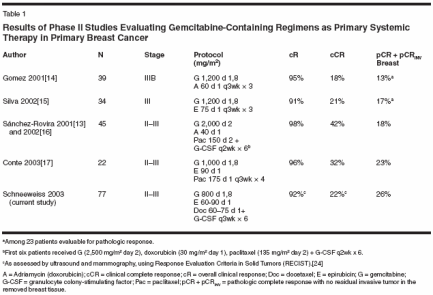
Thus far, results of four phase II studies evaluating gemcitabine-containing regimens as primary systemic therapy in primary breast cancer are available.[14-17] All investigators reported promising clinical and pathologic response rates (Table 1). Gomez et al treated 39 patients with stage IIIB breast cancer with gemcitabine at 1,200 mg/m2/d on days 1 and 8 and doxorubicin at 60 mg/m2 on day 1 every 3 weeks for three cycles.[14] The overall clinical response (cR) rate was 95% (clinical complete response [cCR] rate, 18%), and the pCR rate was 13% (3 of 23 evaluable patients).[ 14] Silva et al reported cR, cCR, and pCR rates of 91%, 21%, and 17% (4 of 23 evaluable patients), respectively, among 34 patients with stage IIIA-IIIB primary breast cancer who received gemcitabine at 1,200 mg/m2 on days 1 and 8 plus epirubicin (Ellence) at 75 mg/m2 on day 1 every 3 weeks * 3.[15] Snchez-Rovira and colleagues completed a phase II study with preoperative biweekly gemcitabine at 2,000 mg/m2, doxorubicin at 40 mg/m2, and paclitaxel at 150 mg/m2 for six cycles, with granulocyte colony-stimulating factor [G-CSF] support. Doses were modified after the first six patients had received gemcitabine (2,500 mg/m2), doxorubicin (30 mg/m2), and paclitaxel (135 mg/m2). Among 45 evaluable patients, the cR, cCR, and pCR rates were 98%, 42%, and 18%, respectively.[13,16] Conte et al presented preliminary results of a phase II study using gemcitabine at 1,000 mg/m2 on days 1 and 8, epirubicin at 90 mg/m2 on day 1, and paclitaxel at 175 mg/m2 on day 1 every 3 weeks for four cycles in patients with stage II-III primary breast cancer. In the first 22 evaluable patients, the cR, cCR, and pCR rates were 96%, 32%, and 23%, respectively.[ 17] In all studies, toxicity was mild to moderate and manageable. All investigators used paclitaxel as the taxane compound. In randomized trials comparing doxorubicin and taxane as monotherapy in advanced breast cancer, however, paclitaxel showed similar or inferior efficacy as compared with doxorubicin,[18,19] whereas docetaxel (Taxotere) achieved higher response rates than did doxorubicin.[20] Therefore, it seemed reasonable to substitute paclitaxel with docetaxel and evaluate docetaxel in combination with gemcitabine and anthracycline as primary systemic therapy in patients with primary breast cancer. Phase I/II Study of Gemcitabine/Epirubicin/ DocetaxelPatients and Methods
We initiated a multicenter phase I/II study in January 2002 to evaluate the triplet combination of gemcitabine, epirubicin, and docetaxel (GEDoc) as primary systemic therapy in patients with biopsy-proven primary breast cancer stage T2-4, N0-2, M0. Partici- pating institutions were the University of Heidelberg, University of Tuebingen, and the Community Hospital Weinheim in Germany. Patients were treated with gemcitabine on days 1 and 8, epirubicin on day 1, and docetaxel on day 1, every 3 weeks at escalating dose levels of 800/60/60 mg/ m2 (dose level 0), 800/60/75 mg/m2 (dose level 1), 800/75/75 mg/m2 (dose level 2), and 800/90/75 mg/m2 (dose level 3), for up to six cycles. Prophylactic filgrastim (Neupogen) was administered from day 2 to day 6 and from day 9 until neutrophil recovery (Figure 1).
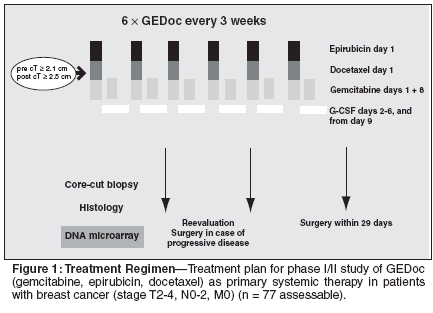
Primary study end points were to define the maximum tolerated dose and to evaluate clinical and pathologic response rates of GEDoc as primary systemic therapy. Secondary end points included the rate of breast-conserving surgery and toxicity. In addition, snap frozen tissue of pretreatment tumor biopsies were collected, and DNA microarray analyses will be performed in the future to ascertain any predictive and prognostic gene expression signatures. This aspect of the study is based on data from van de Vijver et al, who described a gene expression signature in primary breast cancer with prognostic value superior to that of currently used clinical parameters.[ 21] The DNA microarray analyses will be performed in a blinded fashion regarding clinical outcomes by Peter Lichter, PhD, at the German Cancer Research Center in Heidelberg, Germany. Results of these analyses will be correlated with clinical and pathologic responses, time to progression, survival, and toxicity. Results
Through March 2003, 80 patients had been enrolled in the study; 3 patients were not eligible due to primary bone metastases, an uncontrolled psychiatric disorder, or chronic infectious disease. A total of 77 patients were evaluable for clinical and pathologic response, type of surgery, and toxicity.
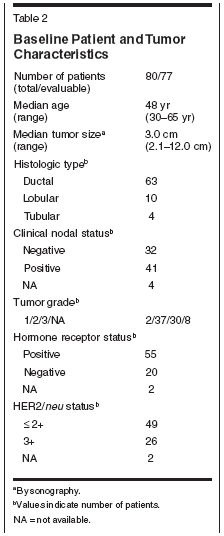
Baseline patient and tumor characteristics are shown in Table 2. The median patient age was 48 years (range: 30 to 65 years), and tumor size was a median of 3.0 cm (as assessed sonographically). The majority of paients had ductal carcinoma, with a negative nodal status in 32, a positive nodal status in 41, and data not available in 4 patients. The majority of tumors were grade 2 or 3, and approximately three-fourths of tumors were hormone-receptor positive. HER2/neu status (Herceptest) was ≤ 2+ in 49, 3+ in 26, and not available in 2 patients. A total of 3 patients were treated at dose level 0, 4 patients at level 1, 7 patients at level 2, and 63 patients at dose level 3 (Table 3). The maximum tolerated dose was reached at dose level 3, when three of nine patients developed dose-limiting toxicity during the first cycle. Dose-limiting toxicities consisted of grade 3 febrile neutropenia (n = 1) and grade 3 diarrhea (n = 2), with toxicities graded according to National Cancer Institute- Common Toxicity Criteria (NCICTC), version 2.0. Among 63 patients treated at the maximum tolerated dose, 56 patients received the six scheduled treatment cycles, 5 patients stopped after the fifth cycle (4 patients due to toxicity and 1 patient refused to proceed), and 2 patients stopped after the fourth cycle due to toxicity. According to the study protocol, doses of epirubicin, docetaxel, or gemcitabine were reduced due to toxicity in 30 patients (48%) after a median of three cycles (range: 1 to 5 cycles). Thirtyfive patients began receiving erythropoietin during chemotherapy. Besides alopecia, NCI-CTC grade 3/4 events that occurred in more than 10% of 63 patients treated at the MTD were leukopenia, 56%/32%; febrile neutropenia, 13%/0%; fatigue, 30%/5%; stomatitis, 27%/0%; lung toxicity, 16%/0%; and diarrhea, 11%/0% (Figure 2A). The most common NCI-CTC grade 3/4 events among all 369 cycles given at the MTD were leukopenia, 32%/6%; febrile neutropenia, 2%/0%; fatigue, 10%/1%; stomatitis, 7%/0%; lung toxicity, 3%/0%; and diarrhea, 2%/0% (Figure 2B).
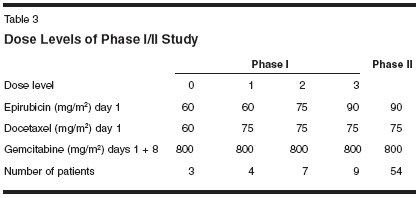
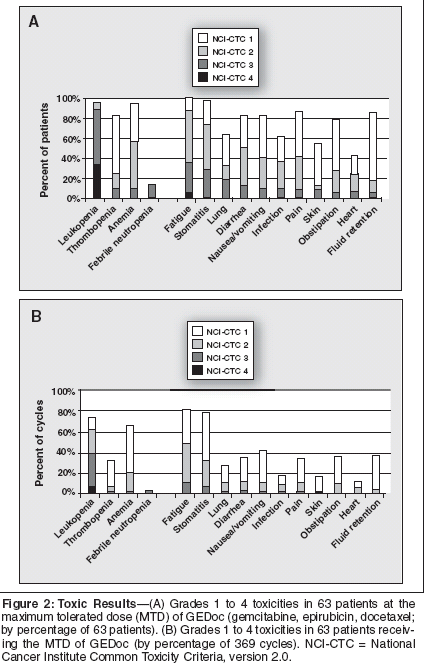
The mean (± standard deviation) and median (range) relative dose intensities, as measured by the summation dose intensity product (SDIP) of the chemotherapy administered divided by the SDIP of the chemotherapy scheduled, were 93% (± 9%) and 97% (66%-100%), respectively. The SDIP that accounted for all three relevant factors of combination chemotherapy in breast cancer, namely, dose intensity, activity, and cumulative dose of each drug, was calculated as described by Hryniuk et al.[22,23] Assessment of response by ultrasound and mammography showed that 17 of 77 patients (22%) achieved a complete remission and 54 patients (70%) a partial remission, for an overall response rate of 92%. No tumor progression occurred. Breast-conserving surgery was possible in 61 patients (79%), with repeat excision required in only 9 patients. In 10 of 77 patients, no invasive or in situ residual tumor was found in resected breast tissue (pCR rate, 13%). Another 10 patients had only in situ residual tumor in the resected breast tissue (pCRINV breast, 13%), for an overall pCR rate in the breast (pCR + pCRINV breast) of 26%. Fifty-five patients (71%) had no lymph node involvement. In 19 of 77 patients, no malignant tumor cells were detected in the resected breast and lymph nodes (pCR + pCRINV breast + nodes). Conclusion Gemcitabine-containing doublets with anthracyclines and gemcitabinecontaining triplets with anthracyclines and taxanes are safe and remarkably active as primary systemic therapy in primary breast cancer. In particular, the triplet combination GEDoc (gemcitabine, 800 mg/m2 on days 1 and 8; epirubicin, 90 mg/m2 on day 1; and docetaxel, 75 mg/m2 on day 1) administered every 3 weeks for six cycles with prophylactic use of filgrastim is well tolerated and highly active as primary systemic therapy, with a clinical response rate as measured by ultrasound and mammography of 92%, a pCR rate in the breast of 26%, and a breast-conserving surgery rate of 79%. Additional assessments will correlate clinical outcomes with results of DNA microarray analyses to identify genetic parameters with prognostic or predictive value.
Disclosures:
Dr. Schneeweiss has received research support from Eli Lilly.
References:
1. Kaufmann M, von Minckwitz G, Smith R, et al: International expert panel on the use of primary (preoperative) systemic treatment of operable breast cancer: Review and recommendations. J Clin Oncol 21:2600-2608, 2003.
2. Fisher B, Bryant J, Wolmark N, et al: Effect of preoperative chemotherapy on the outcome of women with operable breast cancer. J Clin Oncol 16:2672-2685, 1998.
3. Kuerer HM, Newman LA, Smith TL, et al: Clinical course of breast cancer patients with complete pathologic primary tumor and axillary lymph node response to doxorubicin-based neoadjuvant chemotherapy. J Clin Oncol 17:460-469, 1999.
4. Smith IC, Heys SD, Hutcheon AW, et al: Neoadjuvant chemotherapy in breast cancer: Significantly enhanced response with docetaxel. J Clin Oncol 20:1456-1466, 2002.
5. Seidman AD: Gemcitabine as single-agent therapy in the management of advanced breast cancer. Oncology 15(suppl 3):11-14, 2001.
6. Aapro MS, Martin C, Hatty S: Gemcitabine-A safety review. Anticancer Drugs 9:191-201, 1998.
7. Spielman M, Kalla S, Llombart-Cussac A, et al: Activity of gemcitabine in metastatic breast cancer patients previously treated with anthracycline-containing regimens (abstract). Eur J Cancer 33(suppl 8):A663, 1997.
8. Mavroudis D, Malamos N, Alexopoulos A, et al: Salvage chemotherapy in anthracycline-pretreated patients with docetaxel and gemcitabine: A multicenter phase II trial. Ann Oncol 10:211-215, 1999.
9. Fountzilas G, Nicolaides C, Bafaloukos D, et al: Docetaxel and gemcitabine in anthracycline-resistant advanced breast cancer: A Hellenic Cooperative Oncology Group phase II study. Cancer Invest 18:503-509, 2000.
10. Georgoulias VA: Docetaxel/gemcitabine: Salvage chemotherapy in anthracycline-pretreated patients with advanced breast cancer. Oncology 15(suppl 3):18-24, 2001.
11. Alexopoulos A, Kandilis K, Stavrakakis J, et al: Evidence for in vivo synergism between docetaxel (DOC) and gemcitabine (GEM) in patients with metastatic cancer (MBC) (abstract 1945). Proc Am Soc Clin Oncol 20:49b, 2001.
12. Conte PF, Gennari A, Donati S, et al: Gemcitabine plus epirubicin plus Taxol (GET) in advanced breast cancer: A phase II study. Breast Cancer Res Treat 68:171-179, 2001.
13. Sánchez-Rovira P, Jaén A, Gonzáles E, et al: Biweekly gemcitabine, doxorubicin, and paclitaxel as first-line treatment in metastatic breast cancer. Oncology 15(suppl 3):44-47, 2001.
14. Gomez H, Kahatt C, Falcon S, et al: A phase II study of neoadjuvant gemcitabine plus doxorubicin in stage IIIB breast cancer: A preliminary report. Semin Oncol 28(suppl 10):57- 61, 2001.
15. Silva A, Gonzalez H, Perez M, et al: Neoadjuvant gemcitabine plus epirubicin in locally advanced breast cancer: Evidence of activity in a phase II study (abstract 2015). Proc Am Soc Clin Oncol 21:51b, 2002.
16. Sánchez-Rovira P, Jaén A, Duenas R, et al: Neoadjuvant gemcitabine therapy for breast cancer. Clin Breast Cancer 3(suppl 1):S39-S44, 2002.
17. Conte P, Gennari A, Santoro A, et al: Induction chemotherapy in operable breast cancer: A multicenter Italian phase II study with the GET regimen (abstract 140). Proc Am Soc Clin Oncol 22:35, 2003.
18. Paridaens R, Biganzoli L, Brüning P, et al: Paclitaxel versus doxorubicin as first-line single-agent chemotherapy for metastatic breast cancer: A European Organization for Research and Treatment of Cancer randomized study with cross-over. J Clin Oncol 18:724-733, 2000.
19. Sledge GW, Neuberg D, Bernardo P, et al: Phase III trial of doxorubicin, paclitaxel, and the combination of doxorubicin and paclitaxel as front-line chemotherapy for metastatic breast cancer: An intergroup trial (E1193). J Clin Oncol 21:588-592, 2003.
20. Chan S, Friedrichs K, Noel D, et al: Prospective randomized trial of docetaxel versus doxorubicin in patients with metastatic breast cancer. J Clin Oncol 17:2341-2354, 1999.
21. van de Vijver MJ, He YD, van´t Veer LJ, et al: A gene-expression signature as a predictor of survival in breast cancer. N Engl J Med 347:1999-2009, 2002.
22. Hryniuk W, Frei III E, Wright FA: A single scale for comparing dose-intensity of all chemotherapy regimens in breast cancer: Summation dose intensity. J Clin Oncol 16:3137- 3147, 1998.
23. Hryniuk WM, Peters WP, Ragaz J: Determinants of outcome in adjuvant chemotherapy of breast cancer: Dose intensity vs total dose vs dose size (abstract). Breast Cancer Res Treat 64:66, 2000.
24. Therasse P, Arbuck SG, Eisenhauer EA, et al: New guidelines to evaluate the response to treatment in solid tumors. J Natl Cancer Inst 92:205-216, 2000.